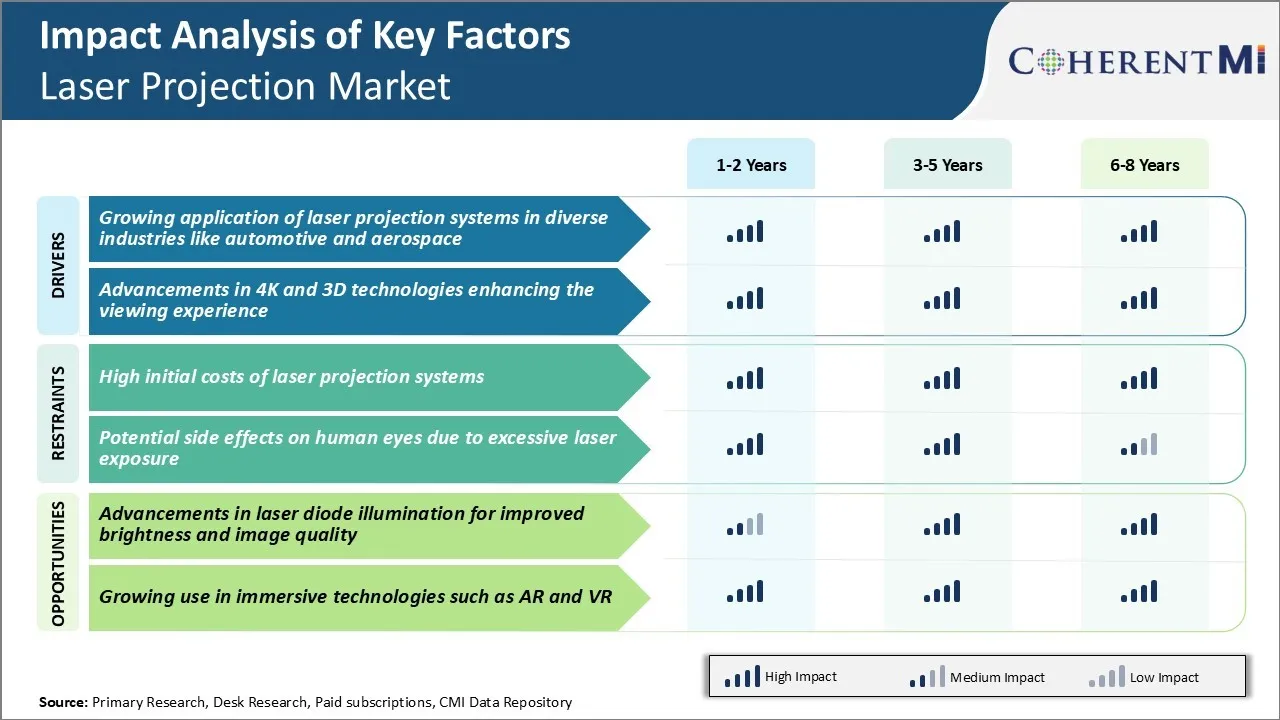Laser Projection Market Trends
Market Driver - Growing Applications of Laser Projection Systems
The laser projection market is witnessing significant traction owing to the growing applications of laser projection across diverse industries. Laser projection systems offer advantages such as high resolution, wide color spectrum, compact size, and portability which is driving their increasing adoption.
In the automotive industry, laser projection systems are emerging as the next generation HUD technology. Major automotive manufacturers are actively working on integrating advanced laser projection HUDs that can project key driving information such as speed, navigation directions, and vehicle diagnostics on the windshield.
In the aerospace industry, laser projection is gaining prominence for cabin and cockpit displays. Major airlines have either installed or are pilot testing laser projection systems for in-flight entertainment. In manufacturing, advanced laser projectors are augmenting workers vision by overlaying assembly instructions directly onto parts or machinery.
The education sector is adopting interactive laser projection for collaborative learning in classrooms. With continual improvements in performance and declining prices, laser projection is expected to become mainstream across multiple applications driving future growth.
Market Driver - Advancements in 4K and 3D Technologies
Technological advancements are enhancing the capabilities of laser projectors, further fueling their adoption. Two major areas which are significantly impacting the laser projection experience are advancements in 4K and 3D technologies. Major brands have already commercially launched affordable 80+ inch 4K laser TVs and projectors with significantly better price to performance than earlier offerings.
Complementing the higher resolution is the advancement of 3D technology for laser projectors. Early adopters have installed 3D laser projectors for mission planning, product visualization as well as gaming and home theaters. Major sporting leagues are evaluating them for new-age 3D broadcasting. With improved performance in factors like brightness, contrast and viewing angles the 3D experience from laser projectors is driving greater adoption across more applications.
Ongoing improvements to lower the cost of active shutter glasses will further accelerate the adoption of laser projection devices. In summary, continuous technological progress in 4K and 3D capabilities is fueling growth of the laser projection market.

Market Challenge - High Initial Costs of Laser Projection Systems
One of the major challenges currently facing the laser projection market is the high initial costs associated with laser projection systems. While the image quality and features of laser projectors are undoubtedly superior to traditional LCD projectors, the upfront expenditure required to purchase a laser projector is considerably higher. This price premium acts as a barrier to adoption, particularly for cost-conscious business and education customers.
Manufacturers also have relatively low production volumes currently, preventing significant economies of scale from being achieved. This prevents costs from coming down substantially. As a result, laser projectors remain out of reach for many potential prosumer and professional clients working with constrained budgets.
Widespread penetration in laser projection market will remain challenging until technologies advance and manufacturing abilities scale to bring the total costs of ownership down to price parity with LCD alternatives.
Market Opportunity - Advancements in Laser Diode Illumination for Improved Brightness and Image Quality
One key area that offers promising opportunities for the laser projection market is ongoing research and development into laser diode illumination technologies. Continuous improvements are being made to laser diodes that allow for increased optical output power while maintaining high reliability. Using multiple laser diodes combined through optics assemblies also enhances overall source brightness.
Advancements are also extending lamp life considerably, lowering long-term operating costs. Additionally, micro-mirror arrays and other spatial light modulation components are advancing to provide enhanced addressability for finer image details and sharper resolutions.
The collective result of power source and image generation enhancements is laser projectors with much higher image quality that can meet the demanding visual needs of commercial presentation spaces, digital signage networks, 3D projection mapping shows, and more. This stronger value proposition will help drive quicker expansion in the laser projection market in the coming years.